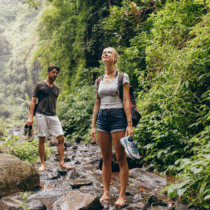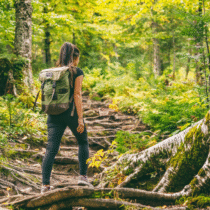A Route 66 road trip offers a unique glimpse into America’s cultural and historical landscape. This iconic highway stretches nearly 2,500 miles from Chicago to Santa Monica, showcasing diverse attractions, classic diners, and historic landmarks along the way. Each stop brings a story, blending nostalgia with adventure that resonates with travelers seeking both history and scenery.
Travelers can experience the charm of small towns, explore quirky roadside attractions, and savor regional cuisines. From the urban vibrancy of Chicago to the scenic coastal views of California, the journey along Route 66 is filled with memorable encounters and discoveries. This road trip is not just about reaching a destination; it’s about embracing the freedom of the open road and the rich heritage that each mile signifies.

The History of Route 66
Route 66, often called “The Mother Road,” has a rich history marked by its significance in American culture and transportation. Its legacy spans several decades, reflecting changes in society, economics, and travel.
The Mother Road’s Beginnings
Route 66 was established on November 11, 1926, as part of the U.S. Highway System. Originally connecting Chicago, Illinois, to Santa Monica, California, it provided a vital link for motorists. The road was about 2,448 miles long and navigated through eight states.
It served as a major thoroughfare for families migrating westward during the Dust Bowl, seeking better opportunities. The highway became a symbol of freedom and mobility in the early 20th century. Various towns along the route capitalized on the influx of travelers by developing infrastructure and amenities.
Route 66 During the Great Depression
During the Great Depression, Route 66 gained prominence as a route for those fleeing economic hardship. People traveled in search of work and better living conditions. Migrant families often used it as a primary pathway to the West Coast.
The road connected hopefuls to California’s agricultural jobs. However, it also highlighted the struggles faced by many Americans. The social impact of these migrations helped shape the demographics of towns along the route, where roadside businesses began thriving in response to increased traffic.
Post-War Prosperity and Decline
After World War II, Route 66 experienced a boom in tourism. The advent of the automobile and the rise of car culture made road trips increasingly popular. Motels, diners, and gas stations flourished, contributing to the economy.
However, the construction of the Interstate Highway System in the 1950s began to overshadow Route 66. Travelers opted for faster, more direct routes, leading to a decline in businesses reliant on highway traffic. Many iconic establishments closed, and parts of the route fell into disrepair as attention shifted elsewhere.
Revival and Cultural Impact
In the late 20th century, nostalgia for Route 66 sparked a revival. The road became a cultural icon celebrated in literature, music, and television. Efforts were made to preserve its historic landmarks and attractions.
Organizations and local communities worked together to promote tourism along the route. Events and festivals emerged to honor its significance. Travelers began rediscovering the charm of the Mother Road, celebrating its heritage as a symbol of American adventure.
Planning Your Route 66 Road Trip
Planning a Route 66 road trip involves several key aspects. Attention to duration, mapping, budgeting, accommodations, and essentials will enhance the experience.
Deciding the Duration
Choosing how long to spend on Route 66 is crucial. A typical trip can take anywhere from a few days to two weeks or more, depending on stops and activities. The entire route stretches about 2,448 miles, so travelers should allocate sufficient time to explore attractions along the way.
For example, spending two weeks allows for a more leisurely pace, while a one-week trip will necessitate prioritizing specific sights. Factors such as travel speed, sightseeing interests, and personal schedules will influence the duration.
Mapping the Route
Mapping out the Route 66 journey is essential for an enjoyable experience. Various online resources can help identify key stops and attractions. Utilizing interactive maps can provide insight into the historical significance of landmarks.
Travelers should consider detours to see lesser-known sites and local gems. Planning stops in cities like Chicago, St. Louis, and Santa Monica offers a blend of roadside attractions and cultural experiences. It is also advisable to account for driving times between major stops to avoid fatigue.
Budgeting Tips
Budgeting for a road trip on Route 66 helps in managing expenses effectively. Key expenses to consider include fuel, accommodations, food, and activities. Drivers should calculate fuel costs based on their vehicle’s mileage and current gas prices.
For accommodations, consider a mix of hotels, motels, and campgrounds to save money. It’s wise to set aside funds for attractions, which may have entrance fees. Using apps and websites for discounts or local deals can further stretch the budget.
Accommodation and Stops
Selecting accommodations along Route 66 requires attention to comfort and convenience. Travelers can choose from various options, including budget motels, boutique hotels, and campsites.
Popular stops include historic sites in places like Williams, Arizona, and Albuquerque, New Mexico. Booking in advance during peak travel seasons ensures a place to stay, especially in smaller towns where options may be limited.
Finding local diners or unique roadside attractions can also enhance the road trip experience by adding flavor and character to the journey.
Packing Essentials
Packing the right essentials is key for a successful road trip. Important items include:
- Clothing: Dress in layers for changing temperatures.
- Food and Snacks: Bring a cooler for refreshments.
- Navigation Tools: Use GPS and physical maps as backups.
- Emergency Kit: Include a first-aid kit, flashlight, and tools.
Additional items like a camera for capturing moments and entertainment options for long stretches of driving will enhance the experience. Being well-prepared ensures travelers can enjoy the journey without unnecessary stress.
Key Attractions Along Route 66
Route 66 offers a rich tapestry of attractions that reflect America’s history and culture. Travelers can explore unique landmarks, quirky roadside stops, and vibrant cities along this iconic highway.
Illinois to Missouri
Starting in Illinois, Route 66 passes through Chicago, where the route is marked by historical sites like the Route 66 Association of Illinois Hall of Fame and Museum. Travelers can experience the bustling energy of the city before heading to attractions like the Chain of Rocks Bridge.
As they move into Missouri, they can stop at the Gateway Arch in St. Louis, a symbol of westward expansion. The city also features the historic Route 66 car museum, showcasing classic vehicles and memorabilia.
Kansas to Oklahoma
Kansas offers the charm of small towns along Route 66. The town of Galena features unique attractions like the Cars on the Route, where visitors can see iconic vehicles from the Pixar movie “Cars.”
Continuing into Oklahoma, tourists can visit the Route 66 Museum in Clinton and the vibrant city of Tulsa. Key stops include the Blue Whale of Catoosa, a colorful roadside attraction that draws visitors for photos and nostalgia.
Texas to New Mexico
In Texas, the route includes the historic town of Amarillo. Tourists can stop at the Cadillac Ranch, an art installation featuring spray-painted Cadillacs buried nose-first in the ground. Nearby, the Big Texan Steak Ranch offers a famous 72-ounce steak challenge.
Crossing into New Mexico, travelers find themselves in Santa Fe, renowned for its Pueblo-style architecture and vibrant arts scene. The Route 66 Diner is a must-visit for those seeking classic American comfort food.
Arizona to California
Arizona showcases natural beauty alongside roadside attractions. The city of Flagstaff serves as a jumping-off point for the stunning Grand Canyon National Park. Travelers can explore Route 66 in Williams, known as the “Gateway to the Grand Canyon.”
As Route 66 approaches California, they reach Barstow, which boasts the Route 66 Museum. The historic town of Needles offers a glimpse of desert life and scenic views, leading up to the famous Santa Monica Pier, the western terminus of Route 66.
Road Safety and Travel Tips
A successful Route 66 road trip requires attention to safety and travel logistics. Being prepared for the unique challenges of this historic route can enhance the experience.
Navigating Historic Sections
Drivers should familiarize themselves with the historic segments of Route 66, as some areas are narrower and winding. Maps and navigation apps are essential tools; offline maps can provide backup where signals may be weak. It’s wise to plan fuel stops, as services may be sparse in remote areas.
Street signs can vary in visibility, so patience is crucial. Speed limits must be adhered to, especially in small towns where they can change frequently. Take breaks to rest; this ensures focus and reduces fatigue on long stretches.
Dealing with Breakdowns
Car troubles can occur unexpectedly. A well-stocked emergency kit should include a spare tire, jack, and basic tools. First aid supplies are also essential. Keeping contact information for roadside assistance handy can provide peace of mind.
In the event of a breakdown, stay with the vehicle and make yourself visible to passing traffic. Use hazard lights and warning triangles to signal distress. If one must leave the car, a safe distance is essential.
Weather Considerations
Weather conditions can vary greatly along Route 66. Checking forecasts before travel assists in planning. Summer can bring extreme heat, making it wise to travel with water and maintain hydration.
In contrast, winter conditions can lead to icy roads in certain segments. Being aware of mountain passes and their potential for snow is vital. Monitoring weather alerts while traveling keeps drivers informed of changing conditions.
Road Etiquette
Courtesy on the road enhances everyone’s experience. Drivers should respect the speed limits and be mindful of local traffic laws. Allowing space for merging vehicles is good practice.
Using turn signals when changing lanes is essential for safety. In tourist-heavy areas, expect pedestrians and cyclists. Increased awareness and patience are necessary to prevent accidents and ensure a smooth journey.
Culinary Journey on Route 66
Traveling along Route 66 offers a unique opportunity to explore diverse culinary experiences. From iconic diners to local specialties, the road is filled with foods that reflect American culture and history.
Iconic Eateries
Route 66 is home to several iconic eateries that have been serving travelers for decades. Lou Mitchell’s in Chicago is a must-stop for breakfast, famous for its pancakes and complimentary donuts.
The Blue Whale in Catoosa, Oklahoma, offers a quirky setting with simple fast-food options. In Amarillo, Texas, Big Texan Steak Ranch is famous for its 72-ounce steak challenge, attracting daring diners.
These establishments embody the spirit of the road and provide a nostalgic experience for visitors.
Local Delicacies
Many areas along Route 66 feature unique local delicacies. In Illinois, travelers can try Italian beef sandwiches, best experienced at Portillo’s.
Arizona offers Navajo tacos, which combine traditional frybread with seasoned beef and toppings.
In New Mexico, the Green Chili Cheeseburger showcases Southwest flavors and can be sampled at various roadside diners. These regional specialties highlight the local culture and history, enhancing the culinary journey.
Dining Experiences Not to Miss
While traveling Route 66, certain dining experiences should not be missed. The Route 66 Diner in Albuquerque features retro decor and classic American favorites.
In Flagstaff, Diablo Burger emphasizes locally sourced ingredients, making their burgers a highlight. Visitors should also stop at The Wagon Wheel in Santa Rosa, offering a genuine dinner experience with homemade pies.
These spots not only offer delicious food but also a glimpse into the unique vibe of their respective locales.
Accommodation Highlights
Route 66 offers a variety of accommodation options catering to different preferences and budgets. From historic hotels to charming motels and serene camping spots, travelers can find cozy and unique places to rest along their journey.
Historic Hotels
Travelers can experience nostalgia at the historic hotels along Route 66. Establishments like the Palace Hotel in Galena, Kansas, boast original architecture and vintage decor, transporting guests back in time.
Another noteworthy mention is the Hotel El Rancho in Gallup, New Mexico. This hotel served as a favorite for Hollywood stars in the 1940s and 1950s. Each room is themed after a famous actor, adding a unique touch to the stay.
Guests may appreciate the rich history and stories behind places like the Château Hotel in Nevada, Missouri, with its charming ambiance and historical significance. These accommodations offer a glimpse into the past while providing modern amenities.
Charming Motels
Charming motels serve as popular resting spots along the iconic highway. The Route 66 Motel in Kingman, Arizona welcomes travelers with its retro decor and friendly service.
Motel Safari in Tucumcari, New Mexico is another appealing option, known for its vintage neon signs and quirky themes. The warm hospitality and unique character of these motels create a comfortable atmosphere.
In addition, many motels feature local artwork and memorabilia, connecting guests to the Route 66 experience. Motels typically offer affordable rates and easy access to nearby attractions, making them ideal for road trippers.
Camping and Caravan Parks
For nature enthusiasts, camping along Route 66 presents a chance to immerse in the landscape. Santa Fe Canyon RV Resort offers spacious sites and scenic views, perfect for an overnight stay.
Bluewater Lake State Park near Prewitt, New Mexico, provides both camping spots and access to fishing and hiking. Campers can enjoy the outdoors while soaking in the peaceful surroundings.
Caravan parks also feature amenities like restrooms, showers, and fire pits, ensuring a comfortable stay. Emphasizing outdoor experiences, these parks cater to those looking to connect with nature during their road trip.
Cultural Sites and Museums
Route 66 offers a rich tapestry of cultural sites and museums that reflect the diverse heritage of the American landscape. From Native American history to vibrant art galleries, there is much to explore along this iconic highway.
Native American Heritage
Route 66 traverses land that is significant to numerous Native American tribes. Important sites include the Pueblo Cultural Center in Albuquerque, which showcases Pueblo history and contemporary culture. Additionally, the Inter-Tribal Indian Ceremonial highlights traditional music, dance, and art of over 25 tribes each August.
Travelers can visit the Navajo Nation, where attractions like Monument Valley offer breathtaking landscapes and insight into Navajo culture. Guided tours often include stories of their ancestral lands, providing visitors with a deeper understanding of Native American life.
Museum Guides
Many towns along Route 66 feature local museums that exhibit regional history. Among them, the Route 66 Museum in Victorville, California, details the highway’s impact on the American economy and culture. The National Route 66 Museum in Elk City, Oklahoma, includes vintage cars and interactive displays.
Each museum typically provides knowledgeable guides who share personal anecdotes and historical context. Visitors can expect well-organized exhibitions that cover everything from the Great Depression to the rise of roadside attractions. These museums serve as valuable resources for anyone interested in American history.
Art Galleries and Installations
Art reflects the spirit of Route 66, with galleries and installations that celebrate local culture. The Museum of Contemporary Art in Los Angeles features works by artists inspired by the American landscape, including pieces reflecting the essence of Route 66.
In Santa Fe, New Mexico, visitors find the Railyard Arts District, showcasing local artists and installations within a vibrant community space. Many galleries host events that celebrate regional art, providing opportunities for networking and cultural exchange. These spaces highlight the connection between art and place, enriching the road trip experience.
Travelers will discover that these cultural venues create a deeper appreciation for the history and artistry found along Route 66.
Natural Wonders
Route 66 offers diverse natural wonders, including stunning landscapes and opportunities for adventure. From national parks to trails, the scenic beauty of this iconic road enhances every road trip experience.
National Parks and Reserves
Several national parks along Route 66 showcase America’s stunning geology and ecosystems. Joshua Tree National Park features unique Joshua trees and striking rock formations. Visitors can explore over 800,000 acres, experiencing the desert’s diverse wildlife.
Petrified Forest National Park holds fossilized trees that date back over 200 million years. Raiing vibrant colors and fascinating formations, it provides a glimpse into prehistoric Earth.
Walnut Canyon National Monument presents cliff dwellings and spectacular views. Hikers can navigate trails that highlight the area’s rich history and natural beauty. Each park offers distinct experiences for nature enthusiasts and casual travelers alike.
Scenic Viewpoints
Along Route 66, numerous scenic viewpoints provide spectacular vistas ideal for photographs. Mirador del Rio offers breathtaking views of the Painted Desert, a region famous for its colorful rock formations and vast plains.
The Route 66 Roadside Attractions Museum features several historical viewpoints, each telling a unique story about America’s past. Travelers can stop to appreciate educational displays while enjoying the scenic charm.
Lookout Point at the Grand Canyon allows visitors to witness the immense canyon with its layered rocks and deep chasms. These spots are perfect for freshly capturing or simply enjoying time in nature.
Hiking and Biking Trails
Outdoor enthusiasts can find numerous hiking and biking trails along Route 66. The Mojave National Preserve features trails that explore the vast deserts, with options for both leisurely walks and more challenging hikes.
The Santa Monica Mountains provide biking paths that offer stunning coastal views and rugged terrain. These trails range from easy rides to more difficult challenges, catering to different skill levels.
Nature lovers can also enjoy the Old Historic Route 66 Trail, a mixed-use path that combines history and beautiful scenery. Each trail adds depth to the Route 66 experience, allowing travelers to immerse themselves in the region’s natural beauty.
Events and Festivals
Route 66 is not just a road; it is a cultural experience marked by numerous events and festivals that celebrate its rich history and vibrant community spirit. These gatherings provide travelers with unique opportunities to immerse themselves in local traditions and enjoy live entertainment.
Music and Entertainment
Music plays a central role in the events along Route 66. Numerous festivals feature live performances from a variety of genres, showcasing local talent and well-known artists alike.
In cities like Flagstaff, Arizona, the Route 66 Summer Fest includes performances across multiple stages, attracting large crowds. Similarly, the Tulsa Blues Festival in Oklahoma celebrates the city’s deep musical roots with local blues bands and renowned performers.
Attendees can enjoy not only concerts but also street performances and dance competitions that capture the lively atmosphere of the road. These events foster community engagement and are often family-friendly, with activities for all ages.
Historical Reenactments
Events dedicated to historical reenactments bring the past of Route 66 to life. Towns like Williams, Arizona, host reenactments that showcase the history of the Mother Road from the 1920s through the 1960s.
Participants often dress in period costumes, illustrating the daily lives of those who traveled the highway. Events typically include vintage car parades and guided tours of historical sites.
Visitors gain insight into the significant role Route 66 played in American culture, especially during the Great Depression and after World War II. These reenactments are educational and create an engaging atmosphere that honors the history of this iconic route.
Seasonal Celebrations
Seasonal celebrations along Route 66 highlight the unique flavor and character of each location throughout the year. The Fall Festival in Albuquerque, New Mexico, features crafts, food vendors, and live music, attracting locals and tourists.
During the winter months, various towns organize holiday-themed events. The Route 66 Christmas Parade in Springfield, Illinois, showcases floats, marching bands, and community spirit, drawing large crowds.
Spring marks events such as the Route 66 Car Show, where classic and custom cars are displayed. Each seasonal celebration provides an opportunity for travelers to experience local culture, cuisine, and festive activities that make each stop memorable.
Shopping and Souvenirs
A Route 66 road trip offers many unique shopping opportunities. Travelers can find antique treasures, local artwork, and memorabilia that capture the essence of this legendary highway.
Antique Shops
Antique shops along Route 66 are a treasure trove for enthusiasts. Many towns feature stores brimming with vintage items, from retro diner signs to classic automobile parts.
Notable Locations:
- Gallup, New Mexico: Offers a range of Native American artifacts.
- Route 66 Antique Mall in Saint Robert, Missouri: Houses a diverse selection of collectibles.
Visitors can explore these shops for unique finds that make perfect gifts or personal keepsakes. The charm of these establishments often lies in their rich history and local stories, enhancing the shopping experience.
Local Artisans
Support for local artisans is prevalent along Route 66. Many towns host artisans who create hand-crafted items that reflect the culture of the region. From pottery to jewelry, these goods provide a personal connection to the landscape.
Popular Items:
- Handmade pottery in Santa Fe, New Mexico.
- Artisan jewelry featuring native stones in Sedona, Arizona.
Shopping from local artisans helps sustain small businesses while providing authentic souvenirs that can’t be found anywhere else. This experience often allows for direct interaction with the creators, making meaningful purchases.
Route 66 Memorabilia
Memorabilia related to Route 66 has become increasingly popular. Stores sell items such as t-shirts, keychains, and wall art celebrating the history of the highway.
Items to Consider:
- Postcards featuring iconic Route 66 landmarks.
- Vintage-style road maps for collectors.
These keepsakes serve as reminders of the journey taken along this historic route. They offer visitors a way to take a piece of the adventure home. Collecting Route 66 memorabilia can become a cherished hobby for many travelers.
Conclusion
A Route 66 road trip offers a unique blend of history, culture, and scenic beauty. Travelers experience small towns, iconic landmarks, and vast landscapes.
Key highlights of the journey include:
- Historic Sites: Route 66 is home to various museums and landmarks reflecting American history.
- Natural Wonders: The route showcases stunning natural landscapes, including mountains and deserts.
- Local Cuisine: Each stop presents opportunities to savor regional dishes, enhancing the travel experience.
Exploring Route 66 allows individuals to connect with the heart of America. The memories created during this journey often last a lifetime.
For those considering this adventure, planning ahead can maximize enjoyment. Researching attractions and accommodations helps in crafting a memorable itinerary.
The allure of Route 66 lies in its rich tapestry of stories and experiences. Each mile traveled tells a different tale, inviting exploration and discovery.







